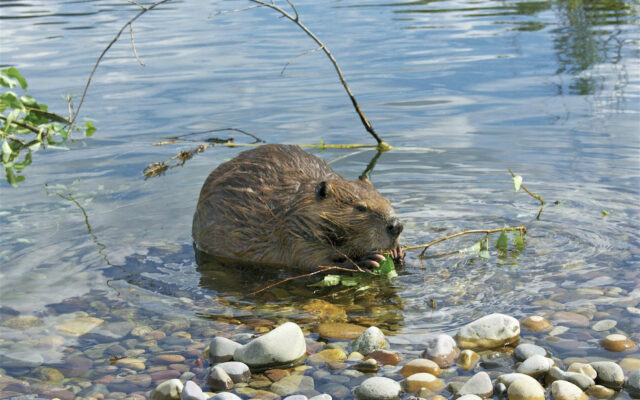
Bill would make it easier for Maine landowners to remove nuisance beavers
By Charles Eichacker, Maine Public
The beaver has been one of the nation’s great ecological comeback stories.
Fur traders mostly wiped out the rodents in the 1800s. But as the demand for pelts fell over the last century and some new forested land has opened up, their numbers have bounced back from an estimated 5,000 in Maine at the start of the last century, to roughly 80,000.
And their ponds have also made a comeback, forming critical habitat for many birds, salamanders and other species.
But their resurgence has come with a human cost: every year, their dams plug up culverts and other critical infrastructure, which can result in costly floods and damage.
Now, a bill before the Legislature would make it somewhat easier for landowners to respond to those challenges.
Right now, Maine law only allows state officials and licensed animal control agents to relocate or kill beavers. But an amended version of that legislation would allow private landowners to eradicate nuisance beavers with special permission from the Maine Department of Inland Fisheries and Wildlife.
Nate Webb, the agency’s wildlife director, said that there are ways to repel beaver short of killing or moving them, and the flooding damage from their dams can also be alleviated in other ways. If the bill is passed, he said experts from the wildlife department would carefully review every case to ensure that the removal is warranted, especially given the importance of beavers to the rest of the environment.
“That allows us to ensure that that is the appropriate step, and that it occurs in a manner that is humane and effective and sensitive to the value that beavers have on the landscape,” he said. “It allows us to use our professional expertise to make sure that the activity occurs in an appropriate way and that it’s actually necessary.”
The bill, from Republican Rep. MaryAnne Kinney of Knox, still hasn’t made it to the full Legislature.
Beavers are considered keystone species, with the ability to form whole habitats on their own as they plug up waterways to create ponds. The accumulation of water then helps them store food and make an entrance for their lodges, according to the wildlife department. That in turn can benefit other species that use the pond.
Researchers are also studying whether beaver ponds can bring other environmental benefits, such as helping to conserve spring snowmelt in areas prone to drought.
But when those dams end up flooding roads, basements and other manmade infrastructure, the damage can be costly. In one particularly dramatic case, the Penobscot County town of Orrington incurred more than $375,000 in repairs after a beaver dam burst twice between 2001 and 2012, damaging a nearby road, according to the Bangor Daily News.
There are also costs associated with preventing that damage.
For example, the Maine Department of Transportation has paid the U.S. Department of Agriculture an average of $73,000 per year over the past five years for modifications to keep beavers from creating detrimental dams, according to Eric Ham, transportation department’s lead biologist and natural resources manager.
A few Mainers testified against Kinney’s bill, citing the importance of beavers to the environment.
Webb said that the addition of the approval process for the wildlife department — which the agency proposed as an amendment to the bill — “strikes the appropriate balance” between protecting beavers while also managing the damage that they can cause.
This article appears through a media partnership with Maine Public.